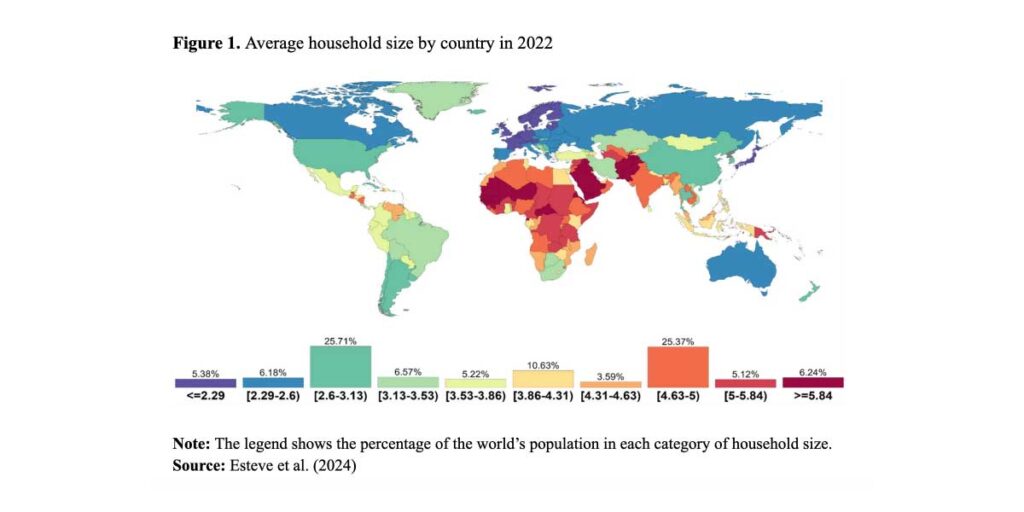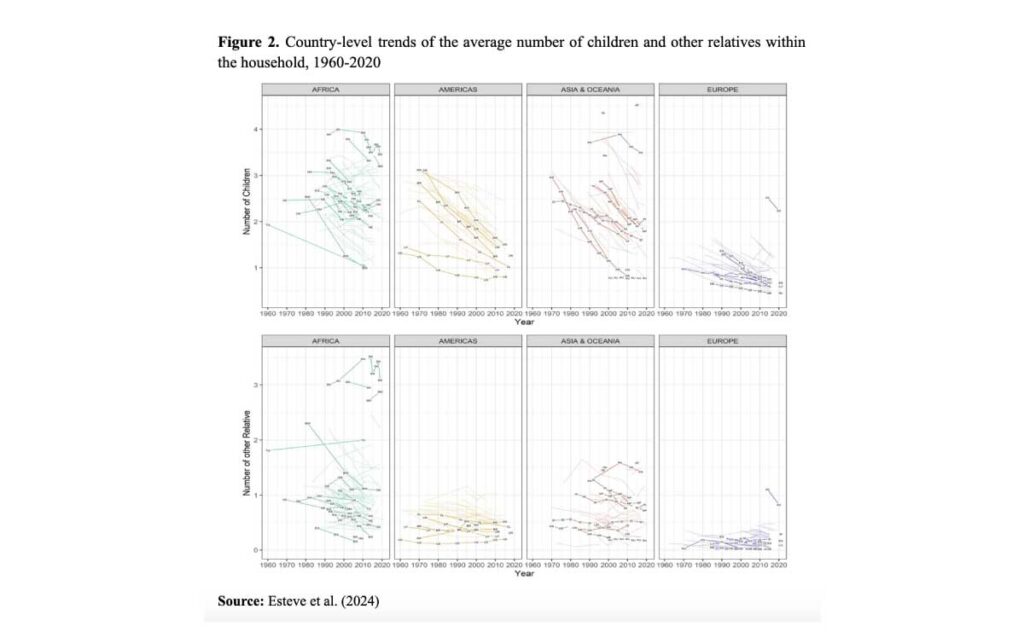Household structures reflect and affect social, economic, and demographic dynamics. Albert Esteve and Maria Pohl use the new CORESIDENCE database to explore the transformation of households over the last five decades. Their findings suggest a global decline in average household size, although household structures continue to differ across countries.
Households are core units of social organization and reproduction. Their fundamental characteristics, namely size and composition, reflect complex socio-economic and demographic changes (Bongaarts, 2001; Therborn, 2004, 2014). For instance, increases in one-person and two-person households at the expense of larger households might be driven by demographic changes, such as fertility decline or increased longevity. Household characteristics can have far-reaching implications for housing markets, intra and inter-household transfers, or gender relations. Studying household size or composition comparatively and over time allows us to understand how societies change, not only from a demographic standpoint but also from social and economic perspectives.
Comparative research on households on a global scale has remained relatively scarce due to data constraints. The newly developed open-access, open-source CORESIDENCE database aids researchers in filling this gap by providing harmonized household data on the national and subnational scales for 156 countries and 1,511 regions (Galeano et al., 2024), making it possible to study families and households on an international scale. Family researchers, like those studying fertility and mortality, can address questions about family change based on the increasing availability of empirical data, thanks to census microdata available from the Integrated Public Use of Microdata Series (IPUMS) and survey data from Demographic Health Surveys (DHS), Multiple Indicator Cluster Surveys (MICS), or the European Labor Force Surveys (EU-LFS).
Converging sizes: moving towards smaller households
Despite some definitional differences, households are considered to be suitable units for comparative research (Bongaarts, 2001). Household size refers to the number of people who are living together in a dwelling at the time of data collection. It differs substantially across countries as it reflects their diverse fertility levels (Figure 1). However, it is also determined by social norms and customs governing family-formation processes, such as norms for establishing a new, separate household upon marriage.

Households are, on average, smallest in some East Asian countries and in Europe. Denmark leads this group, with an average household size of 1.8 people. The largest households, on average, can be found in Sub-Saharan Africa and among countries of the Arabian Peninsula and Central Asia, reaching a maximum of 8.4 people per household in Senegal, for example. The vast majority of the world’s population (around 83 percent) lives in countries with an average household size of between 2.3 and 5 persons.
Household size has declined quite steadily over the past five decades, by approximately 0.5 people per decade. When average household size in a country falls to around two, the rate of decline slows down: countries with comparatively large households and high fertility levels will likely drive any further decline in average household size. Shrinking households in contexts with relatively small households might suggest an increase in one-person households, driven by young adults who postpone their transition to adulthood or by older adults, such as women who live alone after the death of a partner. However, households do not shrink in all contexts: socio-economic conditions may foster intergenerational coresidence or alternative household configurations that could, at least partially, counteract the reduction in household size due to fertility decline. Moreover, some countries (e.g. Senegal) have maintained large households despite demographic changes.
Divergent structures: the roles of children and other relatives
The internal structure of a household is called household composition. This structure is based on a reference person in the household, commonly referred to as the household head or reference person in survey and census data. Household composition varies in response to demographic changes, such as a decline in fertility or changes in family and relationship forms, such as living-apart-together or intergenerational coresidence (Furstenberg, 2019). Household composition further reflects the age structure of a population: the number of children and adults available in a society for distribution across households differs according to the underlying age composition of the population.
Fertility decline is a core driver of shrinking household size. However, across many contexts, the presence of other relatives of the household head is another crucial component of household composition. If the number of children in the household declines but the presence of other relatives remains stable, their relative weight in the household may increase, with possible implications for care transfers, decision-making processes, and family dynamics.
Figure 2 highlights the decline in children in the household (upper panel) across all major world regions. While children are the central driver of global heterogeneity in household size and composition, another important group contributing to global variation in household size and composition is that of other relatives (lower panel). In many countries, the presence of other relatives in absolute numbers has remained relatively unchanged.

Conclusions
Family patterns, socio-economic and demographic transformations, and cultural systems influence the persistent heterogeneity in household composition (Cherlin, 2012). Our results support the “convergence to divergence” hypothesis, which postulates that future family changes driven by social phenomena are certain but will produce different outcomes in different contexts (Pesando & GFC Team, 2019; Therborn, 2004, 2014). Fertility declines increase the prevalence of smaller households, yet we find persistent internal complexity of households in several countries. Interactions of global trends such as declining fertility and increasing life expectancy will result in different typologies of households, depending on the context in which such changes occur. We further anticipate that a continued decline in fertility rates will lead to smaller households and changes in household composition due to fewer living relatives available for coresidence.
The timing and occurrence of life-course events, societal structures, and individual factors drive variation in household structures. Shifts in transfer patterns, housing demand, gender relations, the division of labour, and living arrangements are some of the possible implications of changes in household structures. The CORESIDENCE project investigates these issues by examining links between households, living arrangements, and related socio-demographic indicators. The project entails macro- and micro-level analyses across various contexts, data sources, and spatial levels. We also invite and encourage other researchers to use the CORESIDENCE database.
Funding: CORESIDENCE is supported by an Advanced Grant funded by the European Research Council (ERC). Grant agreement ID: 101052787.
References
Bongaarts, J. (2001). Household size and composition in the developing world in the 1990s. Population Studies, 55(3), 263–279. https://doi.org/10.1080/00324720127697
Cherlin, A. J. (2012). Goode’s World Revolution and Family Patterns : A Reconsideration at Fifty Years. Population and Development Review, 38(4), 577–607. https://doi.org/10.1111/j.1728-4457.2012.00528.x
Esteve, A., Galeano, J., Turu, A., García-Román, J., Becca, F., Fang, H., Pohl, M., & Trias-Prats, R. (2023). The CORESIDENCE Database: National and Subnational Data on Household and Living Arrangements Around the World, 1964-2021. Zenodo. https://doi.org/10.5281/ZENODO.8142652
Esteve, A., Pohl, M., Becca, F., Fang, H., Galeano, J., García-Román, J., Reher, D., Trias-Prats, R., & Turu, A. (2024). A global perspective on household size and composition, 1970–2020. Genus, 80(1), 2. https://doi.org/10.1186/s41118-024-00211-6
Furstenberg, F. F. (2019). Family Change in Global Perspective: How and Why Family Systems Change. Family Relations, 68(3), 326–341. https://doi.org/10.1111/fare.12361
Galeano, J., Esteve, A., Turu, A., García-Roman, J., Becca, F., Fang, H., Pohl, M., & Trias-Prats, R. (2024). CORESIDENCE: National and subnational data on household size and composition around the world, 1964–2021. Scientific Data, 11(1), 145. https://doi.org/10.1038/s41597-024-02964-3
Pesando, L. M., & GFC team. (2019). Global Family Change: Persistent Diversity with Development. Population and Development Review, 45(1), 133–168. https://doi.org/10.1111/padr.12209
Therborn, G. (2004). Between sex and power: family in the world, 1900 – 2000 (Reprinted). Routledge.
Therborn, G. (2014). Family Systems of the World: Are They Converging? In. J. Treas, J. Scott, & M. Richards (Eds.), The Wiley Blackwell Companion to the Sociology of Families (1st ed., pp. 1–19). Wiley. https://doi.org/10.1002/9781118374085.ch1


